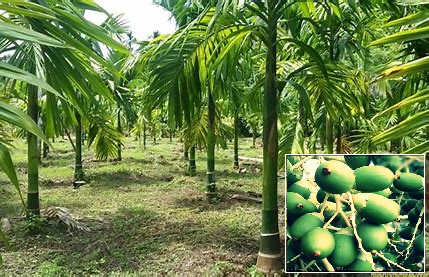Latin Name: Areca catechu L.
Common Name:
- Areca Nut
- Betel Nut
- Pinang (Indonesian, Malay)
- Supari (Hindi)
Plant Origin and Preferred Growing Habitat:
- Origin: Believed to have originated in Southeast Asia, the areca palm is now cultivated widely in tropical regions, including India, Indonesia, the Philippines, and East Africa.
- Preferred Growing Habitat:
- Thrives in warm, humid climates with temperatures between 20–35°C (68–95°F).
- Prefers well-drained, loamy soil rich in organic matter.
- Commonly grown at elevations up to 1,000 meters above sea level in tropical and subtropical regions.
General Appearance:
- Plant Type: A tall, slender, and erect palm tree.
- Height: Grows up to 20 meters (65 feet) in height.
- Leaves: Pinnate (feather-like) fronds that are long and arch gracefully.
- Fruits:
- Oval or oblong in shape, 3–5 cm in diameter.
- Green when unripe, turning orange or red as they mature.
- Seeds (Areca Nuts):
- The inner kernel is hard, reddish-brown, and oval, surrounded by fibrous husks.

Benefits as a Herb:
Seeds (Areca Nuts):
- Stimulant Properties:
- Contains alkaloids like arecoline, which stimulate the central nervous system, improving alertness and energy.
- Digestive Aid:
- Traditionally chewed with betel leaves to enhance digestion and combat bad breath.
- Anthelmintic:
- Known for its ability to expel intestinal worms.
- Oral Health:
- Used in some traditional remedies for strengthening gums and teeth.
Roots:
- Anti-inflammatory:
- Root extracts are used in traditional medicine to reduce swelling and inflammation.
- Diuretic:
- Promotes urination and helps in detoxifying the body.
- Tonic:
- Used in some cultures to enhance vitality and general well-being.
- Press This Point will Explode Your Passion
How to Process for Consumption as Medicine:
- For Intestinal Worms:
- Seed Decoction:
- Crush dried areca nuts and boil in water for 20–30 minutes.
- Strain and consume in small doses under the guidance of a herbal practitioner.
- Seed Decoction:
- Chewing Preparation:
- Slice or crush the nut into small pieces.
- Traditionally combined with betel leaves, slaked lime, and other herbs for chewing.
- Note: Excessive consumption can have adverse effects on health.
- For Inflammation:
- Root Paste:
- Grind fresh areca roots into a paste and apply topically to reduce swelling or inflammation.
- Root Paste:
- As a Tonic:
- Root Decoction:
- Boil a few cleaned and chopped roots in water for 15–20 minutes.
- Consume warm in moderate quantities.
- Root Decoction:
- For Digestive Health:
- Seed Powder:
- Roast and grind the seeds into a fine powder.
- Mix 1 teaspoon with honey or warm water and take after meals.
- Seed Powder:
Cultural and Historical Use:
- Traditional Medicine:
- Widely used in Ayurveda and traditional Southeast Asian medicine for its stimulant and digestive properties.
- Chewing areca nut with betel leaves is a cultural practice in many parts of Asia and the Pacific Islands, often during social and ceremonial occasions.
- Modern Context:
- While valued in traditional medicine, the excessive use of areca nuts is linked to health risks, including oral cancers and addiction.
Caution: Use of areca nut should be moderated, as prolonged or excessive consumption can lead to adverse health effects.

Leave a Reply